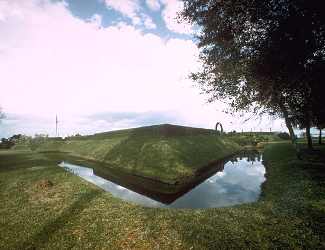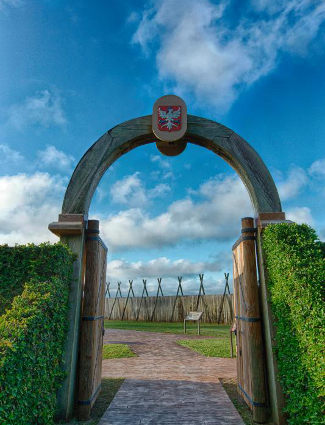
Image above: Reconstruction at Fort Caroline National Memorial. Photo courtesy National Park Service.
Spotlight on Lesser Known History
Battle of Fort Caroline, Florida
America's Best History Spotlight
On this page we're going to Spotlight the lesser known historic sites and attractions that dot the history landscape across the USA and are worth a visit if you're in their area. And while they may be lesser known, some are very unique, and will be that rare find. You'll be, at times, on the ground floor, or maybe even know something others don't. It'll be fun. Visit them.

Battle of Fort Caroline, Florida
The Spanish were mad. They had planned on becoming the predominant force in the colonization of Florida after the expeditions of Ponce de Leon and Hernando de Soto, plus lands north of it, with failed efforts at Charlesfort, South Carolina, and Pensacola, northern Florida, then the establishment of St. Augustine in 1565. Problem was, the French had the same idea, and had started a colony in Timucua territory just north of St. Augustine in the area around today's Jacksonville, Fort Caroline, one year earlier on June 30, 1564. That would not do. The Spanish could not accept French Huguenots, Protestants no less, nearby. So twelve days after the Spanish had their colony started at St. Augustine, they traveled north, and attacked. Spoiler alert. The colony of Fort Caroline was destroyed. Image above: Interior of Fort Caroline. Courtesy National Park Service/Rick Rasmussen.
Sponsor this page for $100 per year. Your banner or text ad can fill the space above.
Click here to Sponsor the page and how to reserve your ad.
Info, What's There Now, History Nearby

Battle of Fort Caroline, Florida
On September 20, 1565, Spanish soldiers under Pedro Menéndez de Avilés attacked the French colony. Prior to arriving at St. Augustine, he had not known of its existence, but took swift action, traveling the thirty miles north with five hundred men. Its not that the French under their leaders René Goulaine de Laudonniére and Jean Ribault, were okay with the Spanish that close either. Jean Ribault had sailed south with six hundred sailors and soldiers, against the wishes of Laudonniére, to find St. Augustine and potentially do something about it, but the ships had been hit by a storm. Hundreds of men were lost; the others shipwrecked to the south, now unable to defend Fort Caroline, except for the few soldiers left behind with Laudonniére, when the Spanish arrived.
Today, the Fort Caroline National Memorial stands to commemorate the French colony and the battle. It is part of the larger Timucuan National Park and Preserve.
Image above: Engraving of Fort Caroline, 1591, painting by Jacques le Moyne de Morgues, engraving by Theodore de Bry. Courtesy Wikipedia Commons. Below: Montage of (left) Pedro Menéndez de Avilés, 1791, Francisco de Paula Marti. Courtesy Library of Congress; and (right) René Goulaine de Laudonniére, Crispijn van de Passe the Elder. Courtesy Wikipedia Commons via Bibliothéque Nationale de France.

Where Is It
Fort Caroline is located at 12713 Fort Caroline Rd., Jacksonville, FL 32225. The Timucuan Preserve Visitor Center is located at the Fort Caroline Memorial site. The site is in the southwest part of the park, adjacent to the Theodore Roosevelt Area of the park and along the St. John's River. Downtown Jacksonville is to the west of the park. Access to the park is by car or the St. John's River Ferry.
Minute Walk in History
Fort Caroline
Take a walk around Ribault's Column, Visitor Center, and reconstructed Fort Caroline as the pirates, or privateers backed by European nations, took sway at Fort Caroline. The French wanted to make a colony in what the Spanish termed their territory in Florida. At first, Jean Ribault had scouted the area and erected a column to himself and his discovery for France, then brought settlers to build a fort and community in 1564-5. Problem was, Ribault left the area, put someone else in charge, and was attacked, first by the tribes in the area, and then by a bloody massacre by Spanish explorer Pedro Menéndez de Avilés and his five hundred soldiers.
What is There Now
At the Fort Caroline section of Timucuan, there's the Timucuan Preserve Visitor Center, with exhibits, orientation, and more, plus the small, reconstructed Fort Caroline, Ribault Monument, nature trails, and waysides. It is situated on one hundred and thirty-eight acres, but Timucuan itself has thousands of acres to explore, including the Kingsley Plantation and the Spanish Pond. There's a picnic pavilion at the Visitor Center.
Within Timucuan, there are two public camping areas at Little Talbot Island State Park and Huguenot Memorial Park.
When Open and How Much
Fort Caroline Memorial and the Timucuan National Park and Preserve are fee free areas. The park is open year round, with exceptions for Major Holidays. Some areas of the park are only open Wednesday to Sunday, including Fort Caroline. Check the park website for any changes in that schedule before you go.
Fees subject to change.
Websites
Fort Caroline National Memorial
Timucuan National Park and Preserve
History Nearby
The area of Fort Caroline, in northern Florida, is near many unique historic, and other, tourist sites. Yes, you're technically part of Timucuan National Park and Preserve, but you are also only thirty miles from St. Augustine. Not too much farther south from there, one hundred and fifty miles or so, and you have the Canaveral sites of Cape Canaveral for the space fan, and Canaveral National Seashore, for the beach crowd.
Buy Chronology

Great Book for the History Fan with Fifty Short Essays Telling the Story of American History.
Photos, History, and More Spotlights

The Spanish Attack
Pedro Menéndez de Avilés knew of Jean Ribault's predicament, but not its severity, and thought that Laudonniére and Fort Caroline would be defended in a weakened state for some time. He selected five hundred men, then began the thirty mile walk amongst the swollen waters and swamps until he reached the vicinity of Fort Caroline three days later. At dawn on the fourth day, September 20, 1565, the Spanish attacked. Pedro Menéndez de Avilés had been correct. The few defenders, two hundred and forty, at the fort were overwhelmed with one hundred and thirty-two killed, leaving Laudonniére and others only defense to escape into the woods. By this time, Jacques, not Jean, Ribault had arrived with several ships on the St. John's River, and had been offered terms of surrender, which he refused.
Photo above: Fort Caroline gate. Courtesy National Park Service/Rick Rasmussen.

The Aftermath
The Spanish captured eight ships, and took command of the fort, renaming it San Mateo. Three hundred soldiers were left to protect it, with Pedro Menéndez de Avilés returning to St. Augustine, afraid of a future attack by Jacques and Jean Ribault, whose ships he wanted to capture, and still without the knowledge of Jean Ribault's predicament. Laudonniére and a party of twenty-six remained in the swamps for several days and were eventually rescued by the ships of Jacques Ribault. They returned to France. Other French parties who remained in the swamp were captured by Spanish soldiers and killed.
Jean Ribault's men and ships, shipwrecked in the tropical storm, were still absent. It was reported in mid-October that he and several hundred men were in the swamps; the Spanish pursued and after consultation with Jean Ribault, they surrendered, not knowing their fate. When asked whether they were Catholic or Protestant, the Catholic in Ribault's party were spared; the remainder, three hundred and fifty, including Jean Ribault, were killed.
The Spanish remained at the site of Fort Caroline, Fort San Mateo, until 1569.
Photo above: The Kingsley Plantation grounds. Date unknown. Courtesy, the Historic American Buildings Survey, Library of Congress.

Fort Caroline and Timucuan
Although the exact site of the fort in not known, a replica of Fort Caroline was established on one hundred and thirty-eight acres as the Fort Caroline National Memorial in 1953. It is located on the south bank of the St. John's River near the commemoration point of Laudonniére's landing and establishment of the French colony.
It is a distinct unit of the National Park Service, but managed by the Timucuan National Park and Preserve. Timucuan, itself, is a splendid park with historical sites of the Timucuan tribe as well as the colonial history of the European families who settled the area.
Photo above: Tabby Ruins, buildings made with a cement mixture based in oyster shells, within the Timucuan Historic Preserve. Source: National Park Service.

T-Shirts and Gifts from the official souvenirs of Americasbesthistory.com.
About
America's Best History where we take a look at the timeline of American History and the historic sites and national parks that hold that history within their lands.
Photos courtesy of the Library of Congress, National Archives, National Park Service, americasbesthistory.com and its licensors.
- Contact Us
- About
- © 2024 Americasbesthistory.com.
Template by w3layouts.

